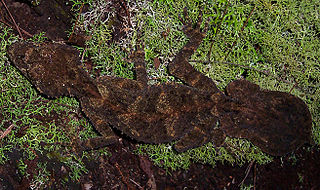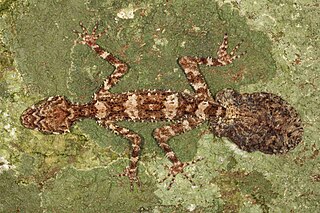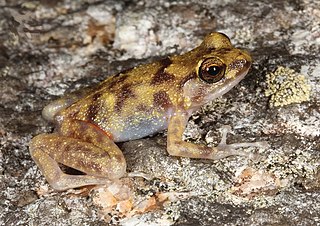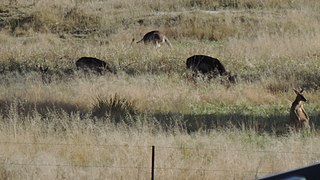
Uroplatus is a genus of geckos, commonly referred to as leaf-tail geckos or flat-tailed geckos, which are endemic to Madagascar and its coastal islands, such as Nosy Be. They are nocturnal, insectivorous lizards found exclusively in primary and secondary forest.

Phyllurus is a small genus of Australian leaf-tailed geckos. Rarely seen outside their native habitat, they are notable for their highly effective camouflage which is in part aided by the spiny tubercles that cover every body part.

Saltuarius is a genus of larger Australian geckos, known collectively as leaf-tailed geckos. The genus was created in 1993 to accommodate some former members of the genus Phyllurus. These geckos appear very similar to the Uroplatus geckos native to Madagascar. However, this is a convergent evolution.

Currumbin is a coastal suburb in the City of Gold Coast, Queensland, Australia. In the 2016 census, Currumbin had a population of 2,920 people.

Saltuarius swaini, also known as the southern leaf-tailed gecko or Border Ranges leaf-tailed gecko is endemic to Australia. where it is found in coastal mountain ranges of southeastern Queensland and northern New South Wales. It inhabits rainforests and lives inside large tree root systems and hollows of strangler figs.

The Shire of Stanthorpe was a local government area of Queensland, Australia on the Queensland-New South Wales border. It was on the Great Dividing Range and was part of the Granite Belt. Its main industries included fruit and vegetable growing, wineries and tourism, and sheep and cattle grazing.

Cape Melville is a headland on the eastern coast of the Cape York Peninsula in Australia. To its west lies Princess Charlotte Bay. It is part of the Cape Melville National Park. Cape Melville was named Stoney Cape in 1815 by Lieutenant Charles Jeffreys on the HM Kangaroo but later renamed by him as Cape Melville
S. occultus may refer to:

The Carphodactylidae are a family of geckos (Gekkota) consisting of 30 described species. All species occur in Australia.

The Cape Melville leaf-tailed gecko is a species of geckos that is endemic to the Melville Range on Cape Melville in Northern Australia. The species was described in 2013 by Australian zoologists Conrad Hoskin and Patrick J. Couper. The lizards are about 20 cm (7.9 in) long and are believed to be a relic species from the time period rainforests were more abundant in Australia. The name derives from the Latin word for "extraordinary" or "exquisite", and refers to the lizard's distinctive, camouflaged appearance. It hides among rocky boulders in the day and emerges at night to hunt on rocks and trees. The lizard has large eyes, a long and slender body, and specialized limbs adapted to life in dimly lit boulder fields.
The Cape Melville shadeskink is a species of lizards from the Cape York Peninsula of Queensland, Australia, described in 2013. It was one of three vertebrates discovered by scientists from James Cook University and National Geographic in an area of mountain rainforest in North Queensland. The lizards are active by day, running and jumping through the mossy boulder fields of Northern Queensland.

Cophixalus petrophilus, the blotched boulder-frog, is a species of frogs from the Cape York Peninsula that was described in 2013. It is one of three newly described vertebrate species from Cape Melville, Australia, the other two being skink Saproscincus saltus and gecko Saltuarius eximius. The specific name petrophilus means "rock-loving" and refers to restriction of this species to boulder field habitats.
Southern leaf-tailed gecko is a common name for several Australian lizards and may refer to:
Lucasium byrnei, commonly known as the gibber gecko or Byrne's gecko, is a species of small, nocturnal gecko, a lizard in the family Diplodactylidae. The species is endemic to Australia.

Lyra is a rural locality in the Southern Downs Region, Queensland, Australia. In the 2016 census, Lyra had a population of 53 people.

The northern leaf-tailed gecko is a species of the genus Saltuarius, the Australian leaf-tailed geckos.
Saltuarius kateae, also known commonly as Kate's leaf-tailed gecko or the Mount Marsh leaf-tailed gecko is a species of gecko, a lizard in the family Carphodactylidae. The species is native to Australia.
Saltuarius moritzi, also known commonly as the New England leaf-tailed gecko or Moritz's leaf-tailed gecko, is a species of lizard in the family Carphodactylidae. The species is native to Australia.
Saltuarius salebrosus, also known as the rough-throated leaf-tailed gecko or Central Queensland leaf-tailed gecko is a gecko found in Australia. It is endemic to dry areas in mideastern and southcentral Queensland.

Wyberba is a rural locality in the Southern Downs Region, Queensland, Australia. In the 2016 census Wyberba had a population of 71 people.










